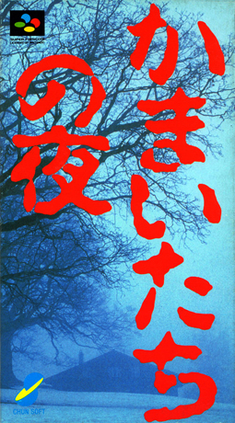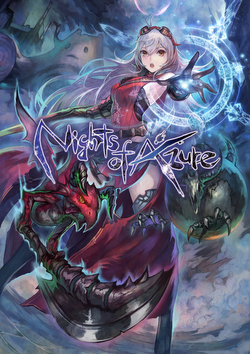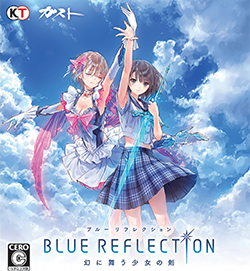
Kamaitachi no Yoru, released in English as Banshee's Last Cry, is a visual novel developed and published by Chunsoft for the Super Famicom in 1994. The game is the second sound novel by Chunsoft and brought a myriad of other companies to develop similar games. The term "sound novel" was a registered trademark, but is regarded as a genre.

The Devil on G-String is a Japanese adult visual novel developed by Akabeisoft2 and first released for Windows as a DVD on May 29, 2008, in limited and regular editions. The gameplay follows an interactive branching plot line with multiple scenarios, and focuses on the appeal of the four female main characters. The title "G Senjō no Maō" comes from August Wilhelmj's "Air on the G String", an adaptation of J.S. Bach's original "Air", and Schubert's Erlkönig known as Maō in Japan.
Ni no Kuni is a series of role-playing video games developed and published in Japan by Level-5; Bandai Namco publishes the games outside Japan. The first games in the series chiefly follow the young Oliver, and his journey to another world to save his mother and stop the beckoning evil. The sequel follows Evan Pettiwhisker Tildrum, a boy king who is usurped from his castle, and sets out to reclaim his kingdom. The games utilize several magic elements, allowing players to use magical abilities during gameplay, and follow groups of characters travelling the fantasy world to put an end to its threats.
Mages Inc., formerly 5pb. Inc., is a Japanese video game developer and record label for video game and anime music.
Akabeisoft2 is a Japanese adult visual novel producing company, emerged from the former doujin circle Akabei Soft. Some of Akabeisoft2's games have had consumer port releases. For example, 5pb. released W.L.O. Sekai Renai Kikō to the Xbox 360 and Yeti brought Tamayura onto the PlayStation 2 and is no longer porting Sharin no Kuni, Himawari no Shōjo.

Wonderful Everyday: Diskontinuierliches Dasein, abbreviated as SubaHibi, is a Japanese visual novel developed by KeroQ. It was released for Windows in 2010 and was given an international release by Frontwing in 2017. It is KeroQ's fourth game after Tsui no Sora, Nijūei and Moekan; it shares many characters and plot elements with Tsui no Sora, of which it is an expanded retelling.

Science Adventure, commonly shortened to SciADV, is a multimedia series consisting of interconnected science fiction stories created by Mages, initially in collaboration with Nitroplus. The main entries mostly take the form of visual novel video games.

Ni no Kuni: Dominion of the Dark Djinn is a role-playing video game developed and published by Level-5. It was released in Japan for the Nintendo DS on December 9, 2010. Players control Oliver, a young boy who sets out on a journey to save his mother. The game is played from a third-person perspective and its world is navigated on foot or by boat. While players navigate Oliver throughout the game's world, other characters can be controlled during battles against enemies; during these battles, players use magic abilities and creatures known as "imajinn", which can be captured and tamed.

Nights of Azure is a 2015 action role-playing video game developed by Gust and published by Koei Tecmo for the PlayStation 3, PlayStation 4, PlayStation Vita and Microsoft Windows. The PlayStation 4 version received a North American release on March 29, 2016, with a European release following on April 1, 2016, and a Microsoft Windows release on February 7, 2017.
There are three mobile games in the Ni no Kuni series published by Level-5. The first two were developed by Level-5 in partnership with mobile distribution companies, and were released around the original games in the main series, Dominion of the Dark Djinn and Wrath of the White Witch. The first, Ni no Kuni: Hotroit Stories, is a role-playing game set before the events of the main entries. It follows the story of Oliver and his friend Mark, and their attempts to construct a car. The first chapter was released in December 2010 through Level-5's Roid service. The second game, Ni no Kuni: Daibouken Monsters, is a social card role-playing game in which players collect cards and use them in battles, and use the abilities of characters who have been trapped in the cards. It was released in a partnership with the GREE mobile service in May 2012. The third game, Ni no Kuni: Cross Worlds, is a role-playing game developed by Netmarble, following a beta tester in a fictional virtual reality game. It was released in Japan, South Korea, and Taiwan in June 2021, and worldwide in May 2022.

Island is a Japanese mystery romance visual novel developed by Frontwing. It was released on 28 April 2016 for Windows. It was later ported to the PlayStation Vita, PlayStation 4 and Nintendo Switch published by Prototype. An English version of the visual novel was released on Steam in August 2018. A 12-episode anime television series adaptation by Feel aired between July and September 2018. Unlike most of Frontwing's releases, Island is not a part of their eroge catalogue.

Steins;Gate: My Darling's Embrace is a visual novel video game developed by 5pb., originally released for the Xbox 360 in 2011. It has since been ported to several other platforms, and was released by Spike Chunsoft in English for the Nintendo Switch, PlayStation 4, and Microsoft Windows in 2019. It is part of the Science Adventure series, and a spin-off from the 2009 game Steins;Gate. The game is a romantic comedy set in a different world from the one in the original Steins;Gate, where the player builds romantic relationships with Steins;Gate characters. By making certain choices and interacting with the player character's cell phone, the player can affect the direction of the plot.

Flowers is a series of yuri-themed visual novel video games developed by Innocent Grey. The first entry, Flowers: Le Volume sur Printemps, was released in 2014; three more games were released in 2015, 2016, and 2017.

Blue Reflection is a role-playing video game developed by Gust. It was published by Koei Tecmo in March 2017 in Japan for the PlayStation 4 and PlayStation Vita, and was released in September 2017 in North America and Europe for the PlayStation 4 and Microsoft Windows. The player takes the role of Hinako Shirai, a ballet dancer who due to a knee injury no longer can dance, but who is given magical power allowing her to fight and move freely. The game follows a day cycle, which sees Hinako attend school and spend time with classmates, and visit another world where she fights monsters in a turn-based battle system. By becoming close friends with her classmates, Hinako can use support abilities from them in battle.

Tokyo Tattoo Girls, known in Japan as Irezumi no Kuni, is a strategy video game developed by Sushi Typhoon Games, Nikkatsu's video game label. It was published for PlayStation Vita as a digital-only title in Japan by Nikkatsu in 2016, and was released internationally for PlayStation Vita and Microsoft Windows by NIS America in 2017. Unlike the original Japanese release, NIS America's Vita version was released physically.

Steins;Gate Elite is a science fiction visual novel and interactive movie video game, part of the Science Adventure series. It was developed by 5pb. for PlayStation 4, PlayStation Vita, Nintendo Switch, Microsoft Windows and iOS, and was released in September 2018 in Japan and in February 2019 internationally. It is an updated, fully animated remake of the 2009 game Steins;Gate, using footage from the anime adaptation of the original game along with newly produced animation by White Fox.

Psychedelica of the Black Butterfly and Psychedelica of the Ashen Hawk are two otome visual novel video games developed by Otomate. They were published for PlayStation Vita by Idea Factory in Japan in 2015 and 2016, and by Aksys Games in North America and Europe in 2018. Intragames and Idea Factory released Black Butterfly for Microsoft Windows in 2018, and Ashen Hawk in 2019.

Eternal Eyes, known in Japan as Koukroseatro: Yūkyū no Hitomi, is a strategy video game developed by TamTam and published by Sunsoft and Crave Entertainment in 1999–2000.














